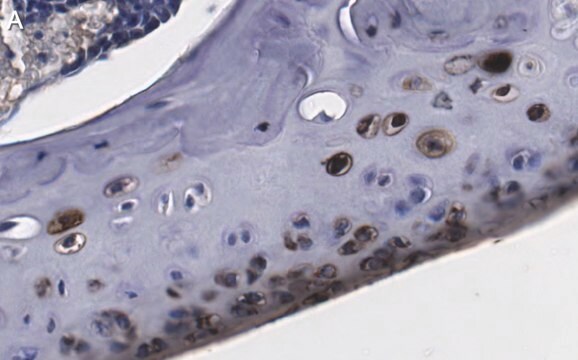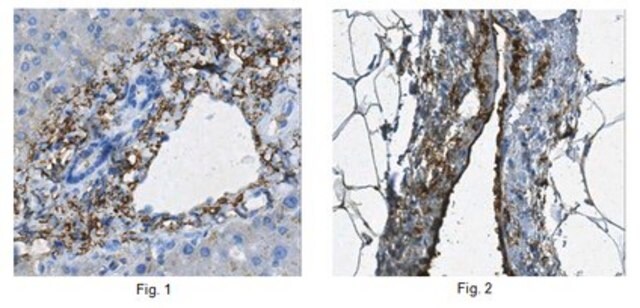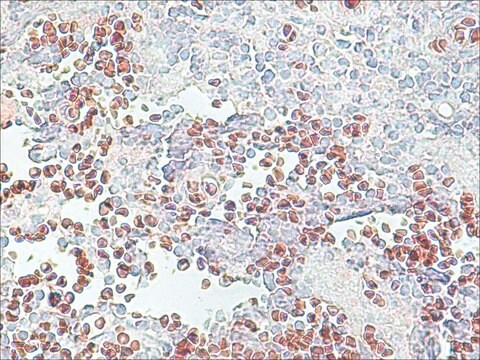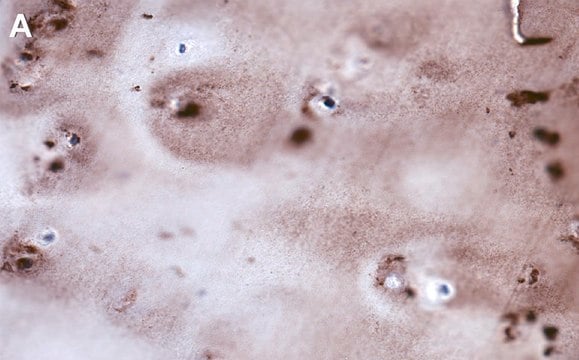MABT401
Anti-Lubricin Antibody/Proteoglycan 4, clone 9G3
clone 9G3, from mouse
Synonim(y):
Proteoglycan 4, Lubricin, Megakaryocyte-stimulating factor, Superficial zone proteoglycan, Proteoglycan 4 C-terminal part
Wybierz wielkość
1960,00 zł
Przewidywany termin wysyłki25 kwietnia 2025Szczegóły
Wybierz wielkość
About This Item
1960,00 zł
Przewidywany termin wysyłki25 kwietnia 2025Szczegóły
Polecane produkty
pochodzenie biologiczne
mouse
Poziom jakości
forma przeciwciała
purified immunoglobulin
rodzaj przeciwciała
primary antibodies
klon
9G3, monoclonal
reaktywność gatunkowa
rat, human
metody
immunohistochemistry: suitable (paraffin)
western blot: suitable
izotyp
IgG1κ
numer dostępu NCBI
numer dostępu UniProt
Warunki transportu
wet ice
docelowa modyfikacja potranslacyjna
unmodified
informacje o genach
human ... PRG4(10216)
Opis ogólny
Immunogen
Zastosowanie
Immunohistochemistry Analysis: A representative lot detected Lubricin/Proteoglycan 4 in articular cartilage tissue (Elsaid, K.A, et al. (2012). Osteoarthritis and Cartilage. 20:940-948).
Immunohistochemistry Analysis: A representative lot detected Lubricin/Proteoglycan 4 in rat arterial cartilage tissue (Jay, G.D, et al. (2012). Arthritis & Rheumatism. 64(4):940-948).
Immunohistochemistry Analysis: A representative lot detected Lubricin/Proteoglycan 4 in articular cartilage from rat
(Manuscript in preparation).
Western Blotting Analysis: A representative lot detected Lubricin/Proteoglycan 4 in lubricin purified from synovial fluid of patients (Manuscript in preparation).
Jakość
Western Blotting Analysis: 0.02 µg/mL of this antibody detected Lubricin/Proteoglycan 4 in 1 µg of Lubricin purified protein.
Opis wartości docelowych
Postać fizyczna
Inne uwagi
Nie możesz znaleźć właściwego produktu?
Wypróbuj nasz Narzędzie selektora produktów.
polecane
Kod klasy składowania
12 - Non Combustible Liquids
Klasa zagrożenia wodnego (WGK)
WGK 1
Temperatura zapłonu (°F)
Not applicable
Temperatura zapłonu (°C)
Not applicable
Certyfikaty analizy (CoA)
Poszukaj Certyfikaty analizy (CoA), wpisując numer partii/serii produktów. Numery serii i partii można znaleźć na etykiecie produktu po słowach „seria” lub „partia”.
Masz już ten produkt?
Dokumenty związane z niedawno zakupionymi produktami zostały zamieszczone w Bibliotece dokumentów.
Active Filters
Nasz zespół naukowców ma doświadczenie we wszystkich obszarach badań, w tym w naukach przyrodniczych, materiałoznawstwie, syntezie chemicznej, chromatografii, analityce i wielu innych dziedzinach.
Skontaktuj się z zespołem ds. pomocy technicznej







